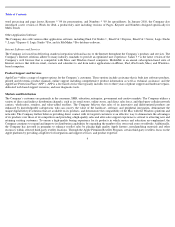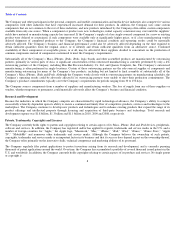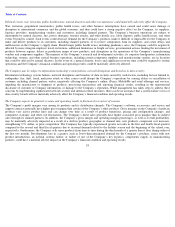Apple 2010 Annual Report Download - page 17
Download and view the complete annual report
Please find page 17 of the 2010 Apple annual report below. You can navigate through the pages in the report by either clicking on the pages listed below, or by using the keyword search tool below to find specific information within the annual report.
Table of Contents
products or services, or the Company’s flexibility to respond to changing conditions. In addition, the Company relies on third-
party
manufacturers to adhere to the Company’
s supplier code of conduct. Although arrangements with such manufacturers may contain provisions for
warranty expense reimbursement, the Company may remain responsible to the consumer for warranty service in the event of product defects.
Any unanticipated product defect or warranty liability, whether pursuant to arrangements with contract manufacturers or otherwise, could
materially adversely affect the Company’s reputation, financial condition and operating results.
Final assembly of the Company’s products is currently performed in the Company’
s manufacturing facility in Ireland, and by external vendors in
California, Texas, China, the Czech Republic and Korea. Currently, the supply and manufacture of many critical components is performed by
sole-sourced third-
party vendors in the U.S., China, Germany, Ireland, Israel, Japan, Korea, Malaysia, the Netherlands, the Philippines, Taiwan,
Thailand and Singapore. Sole-sourced third-party vendors in China perform final assembly of substantially all of the Company’
s Mac products,
iPhones, iPads and iPods. If manufacturing or logistics in these locations is disrupted for any reason, including but not limited to, natural
disasters, information technology system failures, military actions or economic, business, labor, environmental, public health, or political issues,
the Company’s financial condition and operating results could be materially adversely affected.
The Company relies on third-party digital content, which may not be available to the Company on commercially reasonable terms or at all.
The Company contracts with certain third parties to offer their digital content through the Company’s iTunes Store. The Company’
s licensing
arrangements with these third parties are short-
term and do not guarantee the continuation or renewal of these arrangements on reasonable terms,
if at all. Some third-
party content providers currently or in the future may offer competing products and services, and could take action to make
it more difficult or impossible for the Company to license their content in the future. Other content owners, providers or distributors may seek to
limit the Company’
s access to, or increase the total cost of, such content. If the Company is unable to continue to offer a wide variety of content
at reasonable prices with acceptable usage rules, or continue to expand its geographic reach, the Company’
s financial condition and operating
results may be materially adversely affected.
Many third-party content providers require that the Company provide certain digital rights management (“DRM”)
and other security solutions. If
these requirements change, the Company may have to develop or license new technology to provide these solutions. There is no assurance the
Company will be able to develop or license such solutions at a reasonable cost and in a timely manner. In addition, certain countries have passed
or may propose legislation that would force the Company to license its DRM, which could lessen the protection of content and subject it to
piracy and also could affect arrangements with the Company’s content providers.
The Company relies on access to third-party patents and intellectual property, and the Company’
s future results could be materially adversely
affected if it is alleged or found to have infringed intellectual property rights.
Many of the Company’s products are designed to include third-
party intellectual property, and in the future the Company may need to seek or
renew licenses relating to various aspects of its products and business methods. Although the Company believes that, based on past experience
and industry practice, such licenses generally could be obtained on reasonable terms, there is no assurance that the necessary licenses would be
available on acceptable terms or at all.
Because of technological changes in the industries in which the Company competes, current extensive patent coverage, and the rapid issuance of
new patents, it is possible that certain components of the Company’
s products and business methods may unknowingly infringe the patents or
other intellectual property rights of third parties. From time to time, the Company has been notified that it may be infringing such rights.
Regardless of merit, responding to such claims can consume significant time and expense. At present, the Company is vigorously defending a
number of patent infringement cases, and several pending claims are in various stages of evaluation. In certain cases, the Company may consider
the desirability of entering into licensing agreements, although no
14
























